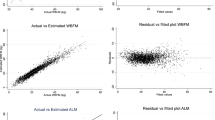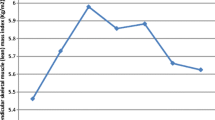Abstract
The aim of this study was to develop reference ranges for total and appendicular lean mass measured using dual-energy X-ray absorptiometry (DXA) from a randomly selected population-based sample of men and women residing in southeastern Australia. Men (n = 1,411) and women (n = 960) aged 20–93 years, enrolled in the Geelong Osteoporosis Study, were randomly selected from the Barwon Statistical Division using the electoral roll as a sampling frame in 2001–2006 (67 % participation) and 1993–1997 (77 % participation), respectively. Using DXA (Lunar DPX-L or Prodigy Pro) at baseline for men and at the 10-year follow-up for women (2004–2008), total and appendicular lean mass were measured. Means and standard deviations for each lean mass measure (absolute and relative to height squared) were generated for each age decade, and cutpoints equivalent to T scores of −2.0 and −1.0 were calculated using data from young adult men and women aged 20–39 years. Young adult reference data were derived from 374 men and 308 women. Cutpoints for relative appendicular lean mass equal to T scores of −2.0 and −1.0 were 6.94 and 7.87 kg/m2 for men and 5.30 and 6.07 kg/m2 for women. The proportions of men and women aged ≥80 years with a T score less than −2.0 were 16.0 and 6.2 %, respectively. These reference ranges may be useful for identifying lean mass deficits in the assessment of muscle wasting and sarcopenia.



Similar content being viewed by others
References
Cruz-Jentoft AJ, Baeyens JP, Bauer JM, Boirie Y, Cederholm T, Landi F, Martin FC, Michel J-P, Rolland Y, Schneider SM, Topinkova E, Vandewoude M, Zamboni M (2010) Sarcopenia. European consensus on definition and diagnosis: report of the European Working Group on Sarcopenia in Older People. Age Ageing 39(4):412–423
Evans WJ, Morley JE, Argilés J, Bales C, Baracos V, Guttridge D, Jatoi A, Kalantar-Zadeh K, Lochs H, Mantovani G, Marks D, Mitch WE, Muscaritoli M, Najand A, Ponikowski P, Rossi Fanelli F, Schambelan M, Schols A, Schuster M, Thomas D, Wolfe R, Anker SD (2008) Cachexia: a new definition. Clin Nutr 27(6):793–799
Mitsiopoulos N, Baumgartner RN, Heymsfield SB, Lyons W, Gallagher D, Ross R (1998) Cadaver validation of skeletal muscle measurement by magnetic resonance imaging and computerized tomography. J Appl Physiol 85(1):115–122
Chen Z, Wang Z, Lohman T, Heymsfield SB, Outwater E, Nicholas JS, Bassford T, LaCroix A, Sherrill D, Punyanitya M, Wu G, Going S (2007) Dual-energy X-ray absorptiometry is a valid tool for assessing skeletal muscle mass in older women. J Nutr 137(12):2775–2780
Andreoli A, Scalzo G, Masala S, Tarantino U, Guglielmi G (2009) Body composition assessment by dual-energy X-ray absorptiometry (DXA). Radiol Med 114(2):286–300
Kelly TL, Wilson KE, Heymsfield SB (2009) Dual energy X-ray absorptiometry body composition reference values from NHANES. PLoS One 4(9):e7038–e7038
Andreoli A, Bazzocchi A, Celi M, Lauro D, Sorge R, Tarantino U, Guglielmi G (2011) Relationship between body composition, body mass index and bone mineral density in a large population of normal, osteopenic and osteoporotic women. Radiol Med 116(7):1115–1123
Karlsson MK, Gärdsell P, Johnell O, Nilsson BE, Akesson K, Obrant KJ (1993) Bone mineral normative data in Malmö, Sweden: comparison with reference data and hip fracture incidence in other ethnic groups. Acta Orthop Scand 64(2):168–172
Tanko LB, Movsesyan L, Mouritzen U, Christiansen C, Svendsen OL (2002) Appendicular lean tissue mass and the prevalence of sarcopenia among healthy women. Metabolism 51(1):69–74
Pasco JA, Nicholson GC, Kotowicz MA (2012) Cohort profile: Geelong Osteoporosis Study. Int J Epidemiol 41(6):1565–1575
Henry MJ, Pasco JA, Seeman E, Nicholson GC, Sanders KM, Kotowicz MA (2001) Assessment of fracture risk: value of random population-based samples—the Geelong Osteoporosis Study. J Clin Densitom 4(4):283–289
Henry MJ, Pasco JA, Korn S, Gibson JE, Kotowicz MA, Nicholson GC (2010) Bone mineral density reference ranges for Australian men: Geelong Osteoporosis Study. Osteoporos Int 21(6):909–917
Baumgartner RN (1998) Epidemiology of sarcopenia among the elderly in New Mexico. Am J Epidemiol 147(8):755–763
Janssen I, Heymsfield SB, Ross R (2002) Low relative skeletal muscle mass (sarcopenia) in older persons is associated with functional impairment and physical disability. J Am Geriatr Soc 50(5):889–896
Bahat G, Saka B, Tufan F, Akin S, Sivrikaya S, Yucel N, Erten N, Karan MA (2010) Prevalence of sarcopenia and its association with functional and nutritional status among male residents in a nursing home in Turkey. Aging Male 13(3):211–214
Melton LJ 3rd, Khosla S, Crowson CS, O’Connor MK, O’Fallon WM, Riggs BL (2000) Epidemiology of sarcopenia. J Am Geriatr Soc 48(6):625–630
Hull HR, Thornton J, Wang J, Pierson RN, Kaleem Z, Pi-Sunyer X, Heymsfield S, Albu J, Fernandez JR, VanItallie TB, Gallagher D (2011) Fat-free mass index: changes and race/ethnic differences in adulthood. Int J Obes 35(1):121–127
Iannuzzi-Sucich M, Prestwood KM, Kenny AM (2002) Prevalence of sarcopenia and predictors of skeletal muscle mass in healthy, older men and women. J Gerontol A 57(12):M772–M777
Gallagher D, Ruts E, Visser M, Heshka S, Baumgartner RN, Wang J, Pierson RN, Pi-Sunyer FX, Heymsfield SB (2000) Weight stability masks sarcopenia in elderly men and women. Am J Physiol Endocrinol Metabol 279(2):E366–E375
World Health Organisation (2003) Prevention and management of osteoporosis. Report of a WHO scientific group. World Health Organ Tech Rep Ser 921:1–164
Acknowledgments
The study was funded by the National Health and Medical Research Council (NHMRC 251638, 299831, and 628582), Perpetual Trustees, and Geelong Region Medical Research Foundation. No funding body played a part in the design or conduct of the study, data analysis, or writing of the manuscript. S. L. B. is the recipient of an NHMRC Early Career Fellowship (1012472)
Author information
Authors and Affiliations
Corresponding author
Additional information
The authors have stated that they have no conflict of interest.
Rights and permissions
About this article
Cite this article
Gould, H., Brennan, S.L., Kotowicz, M.A. et al. Total and Appendicular Lean Mass Reference Ranges for Australian Men and Women: The Geelong Osteoporosis Study. Calcif Tissue Int 94, 363–372 (2014). https://doi.org/10.1007/s00223-013-9830-7
Received:
Accepted:
Published:
Issue Date:
DOI: https://doi.org/10.1007/s00223-013-9830-7




